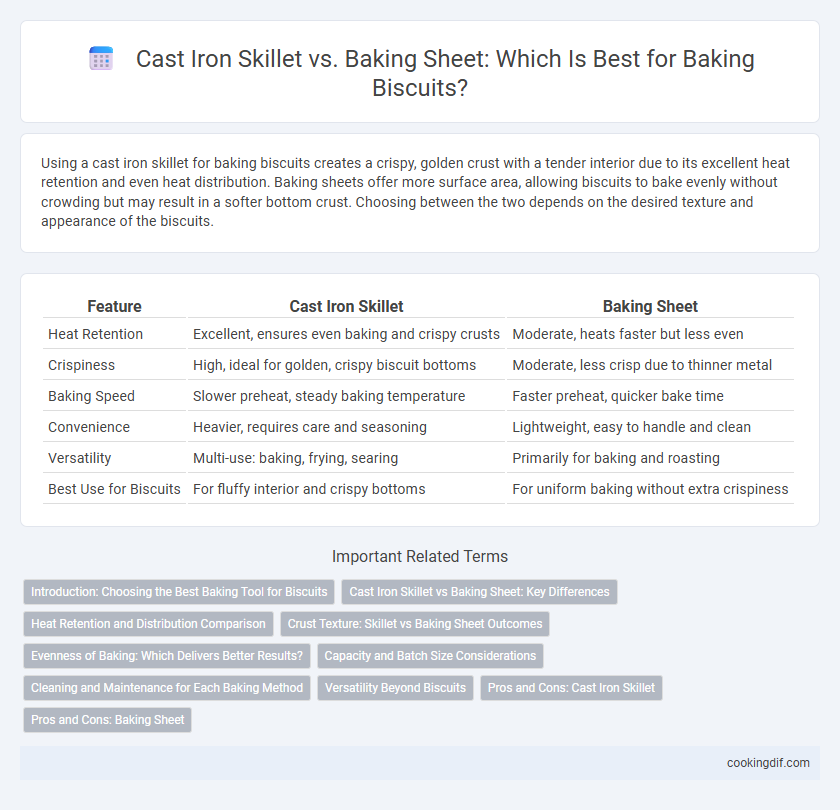Using a cast iron skillet for baking biscuits creates a crispy, golden crust with a tender interior due to its excellent heat retention and even heat distribution. Baking sheets offer more surface area, allowing biscuits to bake evenly without crowding but may result in a softer bottom crust. Choosing between the two depends on the desired texture and appearance of the biscuits.
Table of Comparison
| Feature | Cast Iron Skillet | Baking Sheet |
|---|---|---|
| Heat Retention | Excellent, ensures even baking and crispy crusts | Moderate, heats faster but less even |
| Crispiness | High, ideal for golden, crispy biscuit bottoms | Moderate, less crisp due to thinner metal |
| Baking Speed | Slower preheat, steady baking temperature | Faster preheat, quicker bake time |
| Convenience | Heavier, requires care and seasoning | Lightweight, easy to handle and clean |
| Versatility | Multi-use: baking, frying, searing | Primarily for baking and roasting |
| Best Use for Biscuits | For fluffy interior and crispy bottoms | For uniform baking without extra crispiness |
Introduction: Choosing the Best Baking Tool for Biscuits
Cast iron skillets provide even heat distribution and superior heat retention, creating biscuits with a crispy, golden crust and tender interior. Baking sheets offer quick baking with a thinner crust, ideal for softer biscuits and larger batches. Selecting the best tool depends on desired texture and baking volume, with cast iron enhancing flavor depth while baking sheets maximize convenience and speed.
Cast Iron Skillet vs Baking Sheet: Key Differences
Cast iron skillets offer superior heat retention and even cooking, creating biscuits with a crispy, golden crust and a tender interior, whereas baking sheets provide more even airflow and are ideal for baking multiple biscuits simultaneously with a lighter crust. The thickness and material of cast iron skillets contribute to enhanced browning and a rustic texture, while baking sheets allow for quicker baking times and easier cleanup. Choosing between these methods depends on desired biscuit texture and baking volume.
Heat Retention and Distribution Comparison
Cast iron skillets provide superior heat retention compared to baking sheets, maintaining consistent temperatures that promote even biscuit rising and browning. The dense material of a cast iron skillet facilitates uniform heat distribution, preventing hot spots and ensuring a crisp, golden crust. Baking sheets heat up quickly but tend to lose heat rapidly, resulting in less even cooking and a softer biscuit bottom.
Crust Texture: Skillet vs Baking Sheet Outcomes
Cast iron skillets create a thicker, crunchier crust on biscuits due to their superior heat retention and even distribution, resulting in a golden-brown exterior. Baking sheets produce a lighter, softer crust with less crispness because they heat more gradually and allow moisture to escape more easily. The choice between skillet and baking sheet directly influences the biscuit's texture, with skillets favoring a robust crust and sheets yielding a delicate finish.
Evenness of Baking: Which Delivers Better Results?
Cast iron skillets provide superior heat retention and distribution, ensuring biscuits bake evenly with a crisp golden crust. Baking sheets, while convenient, often result in uneven heat exposure, causing some biscuits to brown more quickly than others. For consistent evenness in baking, cast iron skillets deliver better results, especially when achieving a uniform texture and color is essential.
Capacity and Batch Size Considerations
Cast iron skillets offer superior heat retention and even cooking, making them ideal for baking smaller batches of biscuits with a consistent golden crust. Baking sheets provide a larger surface area, allowing for higher capacity and more biscuits per batch, but may result in less uniform browning. Choosing between the two depends on whether batch size or heat distribution is prioritized in the baking process.
Cleaning and Maintenance for Each Baking Method
Cast iron skillets require thorough cleaning by hand without soap to maintain seasoning and prevent rust, followed by immediate drying and occasional oiling to preserve the non-stick surface. Baking sheets are typically easier to clean, as they can be washed with warm, soapy water and are often dishwasher-safe, but may require scrubbing to remove baked-on residue. Proper maintenance of cast iron improves longevity and enhances flavor, while regular cleaning of baking sheets prevents buildup and extends their usability.
Versatility Beyond Biscuits
Cast iron skillets offer superior heat retention and even cooking, making them ideal for achieving a crispy crust on biscuits while also excelling at searing, roasting, and frying a variety of dishes. Baking sheets provide a larger surface area for baking multiple biscuits simultaneously and are more versatile for cookies, sheet cakes, and roasting vegetables. Choosing between these tools depends on the desired texture and the range of recipes beyond just biscuits.
Pros and Cons: Cast Iron Skillet
A cast iron skillet provides superior heat retention and even heat distribution, resulting in biscuits with a crispy, golden crust and tender interior. Its weight and thickness allow for consistent baking, but the skillet requires proper seasoning and maintenance to prevent sticking and rust. However, the skillet's heavy nature can make handling difficult, and uneven edges may cause irregular biscuit shapes compared to a flat baking sheet.
Pros and Cons: Baking Sheet
Baking sheets provide even heat distribution and a larger surface area, allowing biscuits to bake uniformly with crispier edges. They are lightweight, easy to handle, and typically require less preheating time compared to cast iron skillets. However, baking sheets may produce less browning and may not retain heat as well, resulting in softer biscuit bottoms and less depth in crust texture.
Cast Iron Skillet vs Baking Sheet for baking method Infographic

 cookingdif.com
cookingdif.com